FASTED VS. FED CARDIO: HOW TO FUEL YOUR WORKOUTS FOR THE BEST RESULTS
Fitness Tips
Jun 16, 2025 • 9min read
The debate between fasted vs fed workouts has gained traction among fitness enthusiasts, especially those chasing fat loss, muscle gains or optimized performance. In this blog, we’ll explore the science behind both approaches, outline the benefits and risks and help you find the best strategy for your goals.
WHAT’S THE DIFFERENCE BETWEEN FASTED AND FED WORKOUTS?
Fasted workouts: These are performed after an extended period without food, typically 8 to 12 hours. This approach is typical for early-morning exercisers who haven’t had breakfast. In a fasted state, the body relies more heavily on stored fat as a fuel source, which means you might burn more fat during your workout.
Fed workouts: Happen after you eat something, like a snack or meal. When you eat, your body gets energy from the food, mainly from carbs, which helps power your workout. This extra fuel can help you feel stronger and more energetic, especially during intense exercises like lifting weights or sprinting.
The key distinction between these two methods lies in how the body sources energy and recovers. Fasted workouts might aid in burning fat, but fed workouts can support better output and recovery. Choosing between working out fasted vs fed depends on your specific fitness goals, how your body responds to each method and what type of workout you plan to do.
BENEFITS OF FASTED WORKOUTS
Fasted training offers specific advantages that may help you reach your fitness goals. These workouts are typically done first thing in the morning, before eating and can be especially useful for those looking to burn fat, save time or improve metabolic flexibility. Here are a few key benefits of fasted workouts to consider:
- Burning stored fat: When you exercise without eating beforehand, your body doesn’t have immediate fuel from a recent meal. As a result, insulin levels are typically lower and glycogen stores may be limited, especially during early morning workouts. In this state, your body may shift to using fat, rather than carbs, as its primary energy source, particularly during lower-intensity cardio.
- Fits busy schedules: Fasted workouts can be a major time-saver because you don’t need to prepare or digest a meal beforehand. This makes it easier to squeeze in a sweat session first thing in the morning.
- Helps build routine and focus: Training in a fasted state often means working out first thing in the morning, before the day’s distractions set in. This consistency can create a strong habit loop, while the simplicity of skipping a pre-workout meal helps reduce decision fatigue and sharpen mental discipline.
DRAWBACKS OF TRAINING ON AN EMPTY STOMACH
While fasted workouts have benefits, it’s essential to understand the potential risks of exercising on an empty stomach. Being aware of these factors can help you decide if fasted training is the right fit for your routine:
- Lower energy levels: Without recent fuel, your body may not have the stamina for high-intensity workouts like heavy lifting or HIIT.
- Potential muscle loss: If you’re not recovering properly or eating enough protein throughout the day, your body might break down muscle for energy.
- Lightheadedness or fatigue: When you haven’t eaten before a workout, your blood sugar levels may be lower than usual. This can make it harder for your body to maintain steady energy during longer or more intense sessions. As a result, you might feel dizzy, sluggish or mentally foggy, especially if you’re new to fasted training.
- Slower recovery: After fasted cardio, your body may be running low on energy and nutrients needed for muscle repair. If you don’t refuel soon after, recovery can lag, leading to more soreness and fatigue. Eating a balanced meal post-workout is key to helping your body rebuild and bounce back efficiently.
When to Avoid Fasted Workouts
Fasted workouts aren’t always a good idea for everyone. In some instances, they may cause more harm than good. You should avoid fasted training if:
- You have low blood sugar or diabetes: Exercising without eating can cause blood sugar levels to drop too low, leading to dizziness or even fainting.
- Pregnant or breastfeeding: Your body needs steady nutrients to support your health and your baby’s, so fasting before a workout isn’t recommended.
- You’re new to exercise or tire easily: If you’re still building up stamina, eating beforehand can give you the energy to complete your workouts safely and effectively.
- You’re working on building a healthy relationship with food: If you’ve ever struggled with feeling overly restricted around meals, fasted workouts may not be the best option. Focus on fueling your body in a way that feels supportive and sustainable for you.
BENEFITS OF FED WORKOUTS

Fed workouts have several key benefits that can help you train harder, recover faster and stay consistent with your goals. Here are some of the advantages of exercising after you’ve eaten:
- More energy: Eating before your workout gives your body easily accessible fuel, especially in the form of carbohydrates. This helps maintain blood sugar levels and powers high-intensity activities like weightlifting, sprints or G-Fit classes.
- Supports muscle growth: Having protein and carbs in your system gives your muscles the nutrients they need during exercise. This can reduce muscle breakdown and kickstart the repair process, helping you build strength and size over time.
- Faster recovery: When your body has nutrients available after a recent meal, it can start rebuilding muscle tissue and restoring energy levels right after your workout. This helps you feel less sore and more ready for your next session.
- Flexible timing: Fed workouts are ideal for mid-day or evening sessions since you’ve likely already had one or more meals. This makes it easier to exercise with energy and stay on track with your routine.
When to Avoid Fed Workout
Eating before a workout can often give you the energy boost needed to power through your session. But the timing, food choice and type of workout all play a role in how your body responds. In some cases, a fed workout might not feel like the best option. You may want to skip pre-workout food or adjust your routine if:
- You’re exercising right after a meal: Jumping into a workout too soon after eating can lead to bloating, cramping or nausea. Give your body time to digest—usually 60 to 90 minutes—especially after a larger meal.
- You’re sensitive to food while moving: Some people feel sluggish or uncomfortable when they exercise on a full stomach. If this sounds familiar, try a smaller snack or experiment with fasted workouts to see what feels best.
- You’re following a specific eating plan: Intermittent fasting or other structured meal schedules may make fed workouts harder to coordinate. In those cases, plan to refuel when it makes the most sense for your day.
HOW TO CHOOSE THE BEST APPROACH FOR YOUR FITNESS GOALS

Your ideal training style depends on what you’re working toward in the gym. Here are some goal-based tips to help you decide which approach might be right for you:
- Fat Loss: Fasted cardio can increase fat burning during the workout, but it’s not the only effective method. Fed workouts, especially high-intensity styles like HIIT or G-Fit Bootcamp, also torch calories and can help reduce body fat when paired with a solid nutrition plan.
- Muscle Gain: Fed workouts are the better option here. Your muscles need carbohydrates for energy and protein for growth. Eating before training gives your body the fuel to lift heavy, recover properly and build lean muscle.
- General Health and Fitness: Whether you train fasted or fed matters less than staying consistent. Choose the timing that fits your lifestyle and motivates you to move your body regularly. Both styles can support long-term health if you stick with your workouts.
FASTED CARDIO VS FED CARDIO—WHICH BURNS MORE FAT?
Are you wondering if fasted cardio truly burns more fat? Here’s a simplified breakdown:
- Fasted Cardio: May increase fat oxidation (burning stored fat) during low-to-moderate intensity workouts like walking or cycling.
- Fed Cardio: Fuels high-intensity workouts like G-Fit Bootcamp or HIIT, which burn more calories overall and support better performance.
- Bottom line: Both methods work—what matters most is consistency, workout intensity and your overall nutrition. Choose the one that feels best and helps you stay motivated.
MATCH YOUR WORKOUT STYLE TO YOUR FITNESS GOALS
Finding the right workout style isn’t just about science—it’s about what feels right for your body, goals and schedule. Here’s how to match fasted and fed training to your fitness needs:
Fasted Training Works Best For:
- Early risers who prefer to work out first thing without eating
- Busy professionals looking to maximize limited time in the morning
- Fat loss-focused members aiming to tap into stored fat
- Those building consistency and mental discipline through routine
- Low-to-moderate intensity workouts like steady-state cardio, incline walking or light G-Fit classes
Fed Training Works Best For:
- Strength-focused lifters who need energy to push through heavy reps
- Performance-focused athletes training for endurance or high intensity
- Beginners building stamina, who benefit from a small pre-workout meal
- Mid-day or evening exercisers who’ve already had one or more meals
- High-intensity formats like circuit training, G-Fit Bootcamp or lifting
WHAT TO EAT BEFORE A FED WORKOUT AND AFTER A FASTED ONE

Eating the right foods before and after your workout can make a big difference in how you feel, perform and recover. Whether you’re training fasted or fed, these nutrition tips can help support your goals:
- Before a fed workout: Choose easy-to-digest foods that combine carbohydrates and protein. Great options include a banana with almond butter, oatmeal with a scoop of protein or whole-grain toast with egg whites. Aim to eat 60–90 minutes before your workout for best results.
- After a fasted workout: Refuel with a mix of protein and carbohydrates to support recovery. Try a plate of eggs with toast, a bowl of Greek yogurt topped with berries or a protein shake with a banana and peanut butter. Aim to eat within 1 to 2 hours after finishing your workout to help your body rebuild and restore. energy.
Learn more about meal timing and its impact on your fitness goals here.
PRO TIPS FOR BOTH FASTED AND FED TRAINING
Whether you train on an empty stomach or with a meal beforehand, these tips can help you get the most out of every session:
- Warm up properly: Especially if you’re fasted, warming up helps ease your body into the workout.
- Consider BCAAs for fasted workouts: These can help protect your muscles if you train without food.
- Plan a balanced pre-workout snack: For fed sessions, include carbs and protein for lasting energy.
- Stay hydrated: Water supports every part of your performance, whether fasted or fed.
- Test both in a G-Fit class: Not sure which is right for you? Try each approach in a structured setting and see how your body responds.
CONCLUSION: FIND WHAT FUELS YOU
Both fasted and fed workouts have their place in a well-rounded fitness routine. What’s most important is finding what works best for your energy levels, performance and goals. Try both styles for a few weeks, pay attention to how your body feels and choose the method that keeps you consistent and motivated. Whether training before breakfast or after a pre-workout snack, EōS Fitness has everything you need to succeed. From top-notch equipment to supportive G-Fit classes and expert Personal Trainers, your perfect workout style is waiting. Ready to see what works best for you? Claim your Complimentary 7-Day Pass today and fuel your fitness with confidence!







